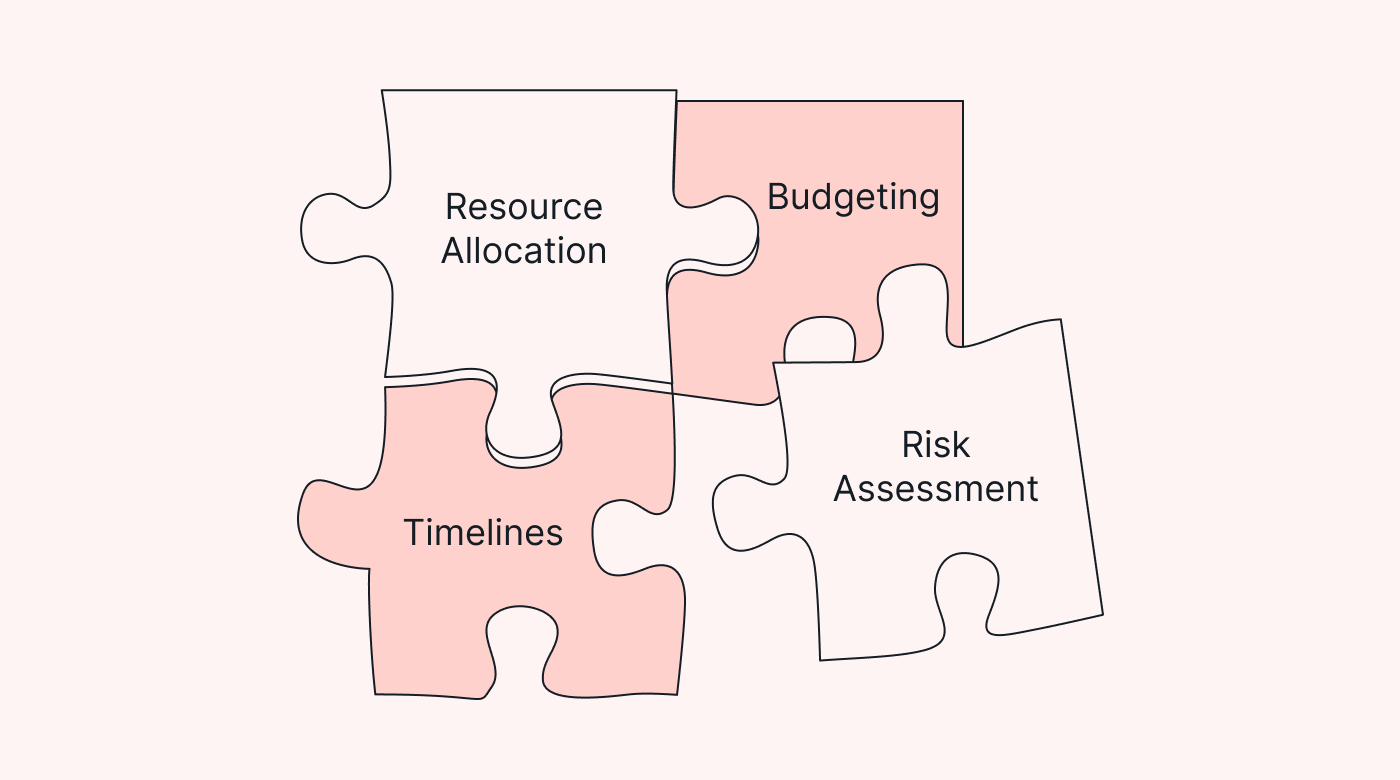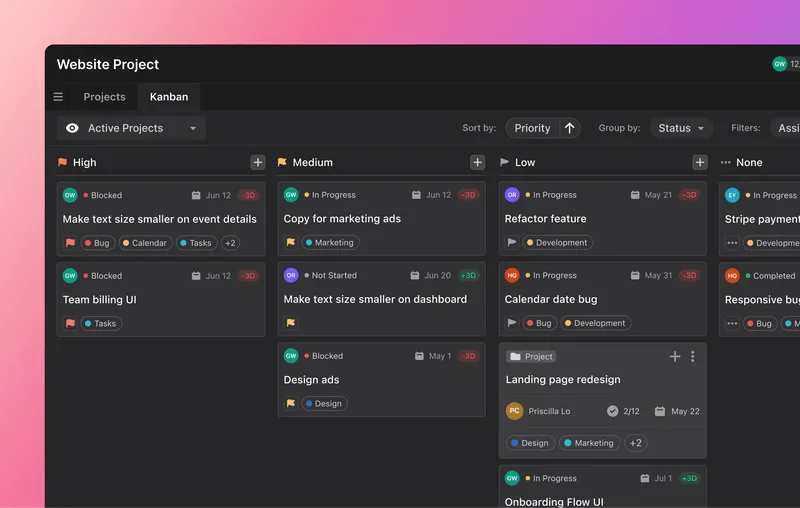Have you ever considered how project management principles could tie into your projects?
These fundamentals (and best practices) give a structured approach to planning and executing any project.
However, the guiding principles are more than a framework for managing projects. They can be a framework for running your business.
In this guide, we'll show you ten principles of project management that you can use for your business and projects right now.
What is a project management principle?
Project management principles are guidelines and best practices for managing projects. They can help you manage projects (and achieve your project goals).
These principles can also help you navigate risks, manage team members, and adapt to changes.
Different methodologies like Waterfall, Agile, and Lean have their own principles.
Waterfall (also known as the traditional method) follows a linear, sequential approach. Its principles focus on meticulous planning and structured execution. With this approach, each phase must be completed before moving on to the next.
It's like building a skyscraper. You lay each floor, one by one, and can't start on the next floor until the previous one is finished.
Agile (which includes the Scrum and Kanban frameworks) flips the script and focuses instead on flexibility and teamwork. Agile uses adaptive planning (sprint planning), progressive growth, and quick iterations. Imagine sculpting a clay masterpiece. You start with a rough shape and refine it gradually until it's perfect.
Lean focuses on eliminating waste and optimizing efficiency. It calls for continuous improvement and the removal of unnecessary steps. It's akin to crafting a delicate piece of origami — every fold serves a purpose.
But here's the real magic: the principles of project management aren't just tools for project managers. They hold incredible value for businesses that adopt them properly.
These principles can help businesses align their work with their strategic goals and business vision. They do so by helping you minimize risks, budget accurately, improve resource use, and, of course, plan out internal or client work.
In short, by implementing these project management principles, you are going a long way to improving your return on investment (and bottom line).
10 important project management principles to apply to any business
You can apply these ten basic project management principles to your business as you see fit. Some are fundamentally similar to general business principles. But all of them will benefit your business in some way.
Principle 1: Clear project (or business) objectives
Without a clear destination in mind, you might find yourself wandering aimlessly. The same goes for businesses without well-defined objectives; they risk getting lost in ambiguity.
Well-thought-out objectives set more than the pace and tone for the rest of the endeavor. They provide clear direction to align your project activities with your overall strategic vision.
For example, a software company aims to develop a new product to meet specific market demands and gain a competitive edge. Good objectives contain the project deliverables (market-ready software), key milestones, features, and client needs.
 |
Tools and techniques used by project managers for identifying and managing objectives:
- Project scope statement: outlines project objectives, project deliverables, and scope boundaries.
- Project charter: defines the business’s vision, objectives, stakeholders, and high-level risks.
- Work breakdown structure (WBS): breaks down the business objectives into manageable project requirements and tasks for easier management.
- Product backlog: lists all the features, requirements, and objectives for Agile projects.
Principle 2: Define clear roles & responsibilities
In soccer, each player has a specific role and responsibility. Together they score goals.
Like a soccer team, roles and responsibilities provide structure, clarity, and direction for business teams.
The entire team knows what's expected of them and how their efforts fit into the larger puzzle. With clear team roles, you'll instill a culture of ownership and responsibility.
Tools and techniques for defining clear roles and responsibilities:
- RACI matrix: stands for responsible, accountable, consulted, and informed. It's a chart where you clearly define those roles for project team members. Bonus: it's simple to implement and understand.
Principle 3: Stakeholder management
Project stakeholders come from within (internal) and outside (external) of a business and are vested in the success of a project (or business).
Think of (all) your stakeholders as important customers.
Good stakeholder management ensures that you understand (and address) stakeholders' requirements. This proactive approach leads to buy-in and support from your stakeholders.
Tools and techniques for stakeholder engagement:
- Stakeholder analysis: Categorize and rank stakeholders based on their influence and interest.
- Stakeholder matrix: A visual tool that gauges stakeholders’ impact and involvement in a project (or business).
Principle 4: Disciplined planning
Thorough planning is the foundation of successful project management (and businesses).
A comprehensive project plan includes critical components such as scope, resource assignment, and risk evaluation.
Good project planning will help keep your project (and business) on track and in line with its objectives.
Tools and techniques for planning:
- The project plan: includes timelines, resource allocation, and key milestones.
- Project management software: includes visual tools that can help you plan (and communicate) the work to be done.
 |
Tip: Businesses should also create contingency plans to address potential risks and uncertainties in the project plan.
Principle 5: Accurate project timelines (and milestones)
Expertise in project time management translates into smarter decisions for business operations.
Just as time is a precious constraint in life, it's equally crucial in projects and businesses. Accurately mapping out the timeline and tracking projects is a valuable art. This is especially important where managing time can make or break projects. If the contractor who pours foundations isn't available for the multi-million-dollar home, the builder might have to look for a more expensive alternative or eat an additional month of an unfinished (and unsold) house.
Milestones are signposts during the project lifecycle, signifying tangible progress. Think of:
- Completing a prototype
- Reaching a particular development phase
- Achieving a sales target
- Launching a new product
- Hitting a revenue target
Tools and techniques for timelines and milestones:
- Project roadmap: outlines, high-level, your project work over time.
- Project schedule: a more detailed version of the project roadmap, which allocates time to the specific tasks.
- Milestones: indicate progress on a roadmap or schedule, like completing the foundation of the house.
Principle 6: Proactive risk management
As Tim Lister and Tom DeMarco aptly put it, “Risk management is how adults manage projects.”
Uncertainties are unavoidable in both projects and businesses. Like in the previous example of the absentee foundation, contractors, projects (and businesses) need to prepare to handle risks proactively. This includes coming up with the proverbial plan B for important activities. Solid risk management planning will help you weather unforeseen disruptions when they pop up.
The home builder in the previous example might have an alternate (or several) foundation contractor in his back pocket.
Tools and techniques for risk management:
- Risk analysis: means identifying potential risks and creating plans to manage them.
- Risk register: lists all the potential risks the business can face.
- Risk matrix: evaluates risks based on potential impacts.
Principle 7: Collaboration
Teamwork makes dreams work.
The power of teamwork is undeniable. The interplay of expertise, ideas, and insights often leads to innovative solutions.
One of the twelve Agile principles suggests, "Business people and developers must work together daily." This tenet isn't just for Agile. It's the cornerstone of successful projects (and businesses).
Agile methodologies focus heavily on teamwork between business managers and development teams. Within Agile, though, leaders take on a servant-leader role.
Think of frontline staff at a restaurant rubbing elbows with managers as they work together to serve the dinner crush. This approach creates a creative problem-solving culture.
Tools and techniques for collaboration:
- Project management software: focuses on collaboration and facilitates effortless communication and file sharing.
Principle 8: Communication
Effective communication is the bridge that connects teams, stakeholders, and business leaders.
 |
Transparent communication is essential for smooth projects or operations.
Hidden agendas create misconceptions, misplaced expectations, and work bottlenecks. Projects and businesses thrive when there's timely, transparent communication (and the work is in sync).
Good communication leads to better collaboration, instills trust, and promotes faster internal decision-making.
Tools and techniques for communication:
- Communication plans: identify and map out communication channels and methods.
Pro tip: Businesses should establish regular communication channels and feedback loops to have a shared understanding of project (or business) progress
Principle 9: Responding to change
Change in projects, life, and business is a certainty. This Agile project management principle is all about handling change and adapting to feedback.
By its nature, Agile accommodates change by working it into the methodology. It's fundamentally designed to embrace change (rather than to "manage" it).
The core way Agile embraces change is to work in short, iterative cycles called "sprints." At the end of each sprint, project teams review progress and adjust their tack based on new insights and evolving priorities.
Agile teams also use sprint retrospectives to see what and how the changes worked (and adapt future work accordingly).
For businesses, this means being ready to adjust strategies, goals, and even product features in relatively short order. When market conditions change, or customer preferences shift, you should be ready.
Tools and techniques for responding to change:
- Change management plan or procedure: to smoothly incorporate possible changes into a project (or business).
 |
Pro tip: Regular project status updates and milestone reports keep stakeholders informed of changes and adjustments.
Principle 10: Continuous improvement
This principle is rooted in Lean project management and is about the never-ending search for doing things more efficiently (and better). It's a practice of consistently refining your processes and strategies.
While it might be never-ending, adopting a continuous improvement mindset will help you and your team avoid complacency (and grow).
At the heart of this principle are post-action reviews. After each project, you examine what went well and what could have been better. This reflection helps to capture lessons learned, which are the nutrients for business growth.
 |
Tools and techniques for continuous improvement:
- Lessons learned: capture mistakes (and feedback) for future projects.
Leverage Motion for your project management
Implementing these project management principles is much easier if you use online tools (software).
Most project management tools are agnostic of the project management methodologies and have features that can help you execute on the ten principles. They often feature visual tools like Kanban boards and timelines for planning and tracking.
But Motion can do more.
For example, Motion can automate workflows and processes. This makes implementing some of the principles autonomous (and boosts the productivity of your team).
Agile methodologies are easy to apply using Motion's Kanban board feature. And with Motion's post-project review feature, continuous improvement becomes second nature. You can even automate retrospectives and let Motion schedule them for you and the project team automatically.
Ready to try out Motion? Sign up for your 7-day free trial.







